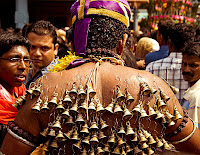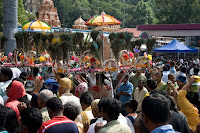by Thilaga

Thaipusam is a special day for honoring Lord Muruga that is celebrated on the full moon in the Tamil month of Thai ( Jan/Feb) . Pusam refers to a star that is at its highest point during the festival. There are many versions of the legend about Thaipusam. One version was a demon named Tharakasuran who was troubling the Rishis and Saints. Lord Muruga was called by his parents Lord Shiva and Parvati and given the task of destroying the asuran. Lord Muruga set off with the blessings of his parents, to destroy the demon. He carried twelve weapons, eleven of which were given by his father Lord Shiva and the 'Vel' given by his mother Parvati. Lord Muruga destroyed Tharakasuran on the Pusam Nakshatra day in the Tamil month of Thai and hence Thai Pusam is celebrated in all Murugan temples.
The other version is that of the great Saint, Agasthya, who instructed his student, Idumban to uproot two hills called Sivagiri and Shakthigiri belonging to Lord Muruga and bring it back to him. As commanded, Idumban flew to Mount Kailai range where the hills rested and picked them up and was about to fly back. But Lord Muruga wanted to test Idumban's mettle and devotion to his master. He reduced his size, to that of a small child and promptly stood atop one of the hills. Suddenly Idumban found that he couldn't carry the hills anymore. To his bewilderment, a child was standing haughtily on the hill. Idumban humbly requested the boy to get down. When the child refused, Idumban flew into a rage and tried to attack him, only to find himself falling like an injured bird. Lord Murugan then reverted to his original self and appeared before Idumban. "I am pleased with your courage and determination," he said. "Your devotion to your guru is admirable. I now bestow on you the honor of being my guardian" Lord Muruga then proclaimed that henceforth, those who carried kavadis to see him, would receive his blessings. Today, thousands of Hindus carry kavadis as offerings to the Lord during Thaipusam. The kavadis symbolize the hills of burden that Idumban shouldered.
No matter what the legends say, the rites that followed are very similar. On the auspicious Thaipusam, devotees make offerings to Lord Muruga for removing the ills that are upon us. Thaipusam celebrated in a very grand manner at all Murugan Temples all over the world including Malaysia.
 Kuala Lumpur, Thaipusam is celebrated on a large scale at the Batu Caves temple on the outskirts of the city. It all began in 1892, by Tamils who migrated to colonial Malaya. It is reported two of them made a difficult trek up the limestone hill and planted the 'vel' in the cave. Thereafter the football field sized cave been dedicated to Lord Muruga as one of his temple . The magnificant shape of the cave and to reach the top, the devotees have to climb the 272 steps. At bottom of the steps, stands up high and tall is the gold statue of Lord Muruga. During this auspcious day devotees swamp Batu Caves to give their offering and thank Lord Murugan.
Kuala Lumpur, Thaipusam is celebrated on a large scale at the Batu Caves temple on the outskirts of the city. It all began in 1892, by Tamils who migrated to colonial Malaya. It is reported two of them made a difficult trek up the limestone hill and planted the 'vel' in the cave. Thereafter the football field sized cave been dedicated to Lord Muruga as one of his temple . The magnificant shape of the cave and to reach the top, the devotees have to climb the 272 steps. At bottom of the steps, stands up high and tall is the gold statue of Lord Muruga. During this auspcious day devotees swamp Batu Caves to give their offering and thank Lord Murugan.
At the eve of the day, a five tone silver chariot bearing the image of Lord Muruga followed by devotees leaves the Sri Mahamariamman temple from the city of Kuala Lumpur , 15 kilometer track to Batu Caves. Devotees living on these routes will give their offering to god, beared on the chariot.
Devotees give their offering and respect to lord by carrying kavadies. On this day, we could witness spectacular kavadies with various shapes and sizes, from the simple shape of a hawker's storehouse (a wooden stick with two baskets at each end, slung across the shoulder) to the costly palanquin structure, profusely flower-bedecked and decoratively interwoven with peacock feathers. SOme devotees spear their cheeks with long, shiny steel rods - often a metre long - and pierce their chests and backs with small, hook-like needles in penance. The tourist are astonished as these infliction does not seem to cause any pain or bleeding to the bearer. Although many researchers from various country suggest its possible there is no bleeding or pain due to the ash or lime juice used during the piercing. But most are just mere speculation. But devotees believe that it is Lord Muruga who is preventing the pain and bleeding. Kavadies bearers also claim to be in a spiritual trance that makes the pain go away.





Others also carry a small pot of milk up the stairs and pour it on the 'vel' at the caves. Devotees also shave their heads bald as they have vowed to the god. Most of the devotees will have to maintain a strict vegetraian diet about 40 days. They will spend the 40 days by meditating and praying to Lord Muruga. Several Chinese devotees and people of other religion and race have also come to fulfill their vows on this day as Thaipusam is the day for thanksgiving and seeking forgiveness from the Lord.












